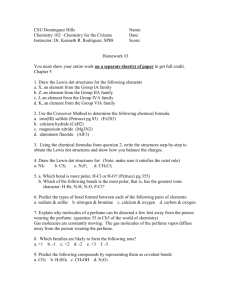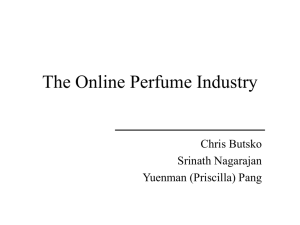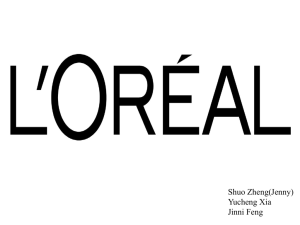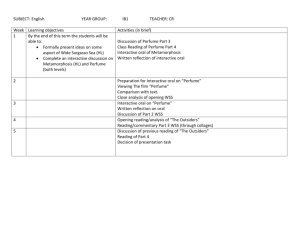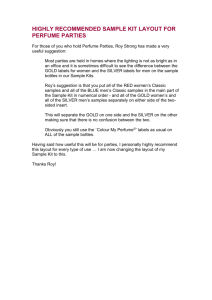Perfume Perfume Perfume
advertisement
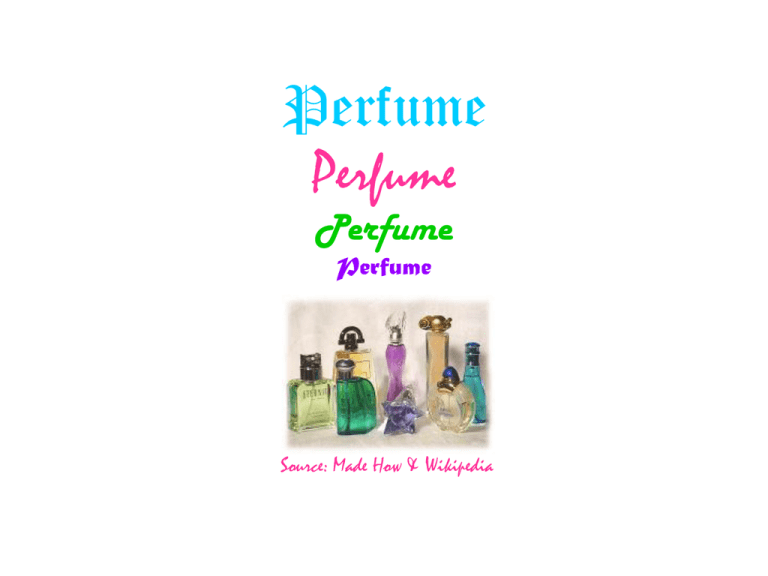
Perfume Perfume Perfume Perfume Source: Made How & Wikipedia Introduction Perfume is a mixture of fragrant essential oil and aroma c o m p o u n d s , f i xa t i v e s , an d solvents used to give the human body, objects, and living spaces a p l e a s a n t s m e l l . Perfume is associated in many cultures with the sensual and romantic side of life. Bottles of some notable commercial perfumes: (clockwise from top left) Bois De Violette, Serge Lutens, 1992; Angel, Thierry Mugler, 1994; Shalimar, Guerlain, 1925; Beyond Paradise, Estée Lauder, 2003; No. 5, Chanel, 1921 (Pre-1950 bottle); Cabochard, Parfums Grès, 1959 (original bottle); Bellodgia, Caron, 1927; Arpège, Lanvin, 1927 (original bottle); Nombre Noir, Shiseido, 1981; Mitsouko, Guerlain, 1919; Pour Un Homme, Caron, 1934. Background Since the beginning of recorded history, humans have attempted to mask or enhance their own odor by using perfume, which emulates nature's pleasant smells. Many natural and man-made materials have been used to make perfume to apply to the skin and clothing, to put in cleaners and cosmetics, or to scent the air. Because of differences in body chemistry, temperature, and body odors, no perfume will smell exactly the same on any two people. Perfume comes from the Latin "per" meaning "through" and "fumum," or "smoke." Many ancient perfumes were made by extracting natural oils from plants through pressing and steaming. The oil was then burned to scent the air. Today, most perfume is used to scent bar soaps. Some products are even perfumed with industrial odorants to mask unpleasant smells or to appear " u n s c e n t e d . " While fragrant liquids used for the body are often considered perfume, true perfumes are defined as extracts or essences and contain a percentage of oil distilled in alcohol. Water is also used. The United States is the world's largest perfume market with annual sales totaling several billions of dollars. History According to the Bible, Three Wise Men visited the baby Jesus carrying myrrh and frankincense. Ancient Egyptians burned incense called kyphi—made of henna, myrrh, cinnamon, and juniper—as religious offerings. They soaked aromatic wood, gum, and resins in water and oil and used the liquid as a fragrant body lotion. The early Egyptians also perfumed their dead and often assigned specific fragrances to deities. Their word for perfume has been translated as "fragrance of the gods." It is said that the Moslem prophet Mohammed wrote, "Perfumes are foods that reawaken the spirit.“ Eventually Egyptian perfumery influenced the Greeks and the Romans. For hundreds of years after the fall of Rome, perfume was primarily an Oriental art. It spread to Europe when 13th century Crusaders brought back samples from Palestine to England, France, and Italy. Europeans discovered the healing properties of fragrance during the 17th century. Doctors treating plague victims covered their mouths and noses with leather pouches holding pungent cloves, cinnamon, and spices which they thought would protect them from disease. History Perfume then came into widespread use among the monarchy. France's King Louis XIV used it so much that he was called the "perfume king." His court contained a floral pavilion filled with fragrances, and dried flowers were placed in bowls throughout the palace to freshen the air. Royal guests bathed in goat's milk and rose petals. Visitors were often doused with perfume, which also was sprayed on clothing, furniture, walls, and tableware. It was at this time that Grasse, a region of southern France where many flowering plant varieties grow, b e c a m e a l e a d i n g p r o d u c e r o f p e r f u m e s . Meanwhile, in England, aromatics were contained in lockets and the hollow heads of canes to be sniffed by the owner. It was not until the late 1800s, when synthetic chemicals were used, that perfumes could be mass marketed. The first synthetic perfume was nitrobenzene, made from nitric acid and benzene. This synthetic mixture gave off an almond smell and was often used to scent soaps. In 1868, Englishman William Perkin synthesized coumarin from the South American tonka b e a n t o c r e a t e a f r a g r a n c e t h a t s m e l l e d l i k e f r e s h l y s o w n h a y. History Ferdinand Tiemann of the University of Berlin created synthetic violet and vanilla. In the United States, Francis Despard Dodge created citronellol—an alcohol with rose-like odor—by experimenting with citronella, which is derived from citronella oil and has a lemon-like odor. In different variations, this synthetic compound gives off the scents of sweet pea, lily of the valley, narcissus, and hyacinth. Just as the art of perfumery progressed through the centuries, so did the art of the perfume bottle. Perfume bottles were often as elaborate and exotic as the oils they contained. The earliest specimens date back to about 1000 B.C. In ancient Egypt, ne wl y invented glass bottles were made largely t o hold perfumes. Egyptian scene depicting t he p r e pa r a t i on o f Li l y p e r f u m e The crafting of perfume bottles spread into Europe and reached its peak in Venice in the 18th century, when glass containers assumed the shape of small animals or had pastoral scenes painted on them. Today perfume bottles are designed by the manufacturer to reflect the character of the fragrance inside, whether light a n d f l o w e r y o r d a r k a n d m u s k y. Describing a perfume The precise formulas of commercial perfumes are kept secret, but even if they were widely published would be dominated by such complex chemical procedures and ingredients that they would be of little use in providing a useful description of the experience of a scent. Nonetheless, connoisseurs of perfume can become extremely skillful at identifying components and origins of scents in the same manner as wine experts. Shelves of perfumes The most practical way to start describing a perfume is according to its concentration level, the family it belongs to, and the notes of the scent, which all affect the overall impression of a perfume from first application to t h e l a s t l i n g e r i n g h i n t o f s c e n t . Describing a perfume Concentration levels Perfume oil is necessarily diluted with a solvent because undiluted oils (natural or synthetic) contain high concentrations of volatile components that will likely result in allergic reactions and possibly injury when applied directly to skin or clothing. By far the most common solvent for perfume oil dilution is ethanol or a mixture of ethanol and water. Dilutions of the perfume oil can also be done using solvents such as jojoba, fractionated coconut oil or wax. The concentration by percent/volume of perfume oil is as follows: Perfume extract: 20%-40% aromatic compounds Eau de parfum: 10-30% aromatic compounds Eau de toilette: 5-20% aromatic compounds Eau de cologne: 2-5% aromatic compounds Eau de cologne (EDC) was originally a specific fragrance of a citrus nature and weak in concentration made in Cologne, Germany. However in recent decades the term has become generic for a weakly concentrated perfume of any kind. Describing a perfume Olfactive families Grouping perfumes, like any taxonomy, cannot ever be a completely objective or final process. Many fragrances contain aspects of different families. Even a perfume designated as "single flower", however subtle, will have undertones of other aromatics. "True" unitary scents can rarely be found in perfumes as it requires the perfume to exist only as a singular aromatic material. Classification by olfactive family is a starting point for a description of a perfume, but by it cannot by itself denote the specific characteristic of that perfume. Traditional T h e t r a d i t i o n a l c l a s s i f i c a t i o n wh i c h e m e r g e d a r o u n d 1 9 0 0 wa s : Single Floral: Fragrances that are dominated by a scent from nature's most prolific odor-makers, the flowers. In French called a soliflore (as in Dior's D i o r i s s i m o , w i t h l i l y o f t h e v a l l e y ) . Floral Bouquet: Containing the combination of several flowers in a scent. Describing a perfume Ambery: A large fragrance class featuring the scents of vanilla and animal scents together with flowers and woods. Can be enhanced by camphorous oils and incense resins, which bring to mind Victorian era imagery of the M i d d l e E a s t a n d F a r E a s t . Woody: Fragrances that are dominated by the woody scents, typically of sandalwood and cedar. Patchouli, with its camphoraceous smell, is c o m m o n l y f o u n d i n t h e s e p e r f u m e s . Leather: A family of fragrances which features the scents of honey, tobacco, wood, and wood tars in its middle or base notes and a scent that a l l u d e s t o l e a t h e r . Chypre: Meaning Cyprus in French, this includes fragrances built on a similar accord consisting of bergamot, oakmoss, patchouli, and labdanum. This family of fragrances is named after a perfume by Francois Coty by the s a m e n a m e . Fougère: Meaning Fern in French, built on a base of lavender, coumarin and oakmoss. Houbigant's Fougère Royale pioneered the use of this base. Many men's fragrances belong to this family of fragrances, which is characterized by its sharp herbaceous and woody scent. Describing a perfume Modern Since 1945, great advances in the technology of perfume creation (i.e. compound design and synthesis) as well as the natural development of styles and tastes, a new classification has emerged to reflect modern s c e n t s : Bright Floral: combining the traditional Single Floral & Floral Bouquet c a t e g o r i e s . Green: a lighter and more modern interpretation of the Chypre type. Oceanic/Ozone: the newest category in perfume history, appearing in 1991 with Christian Dior's Dune. A very clean, modern smell leading to many of t h e m o d e r n a n d r o g e n o u s p e r f u m e s . Citrus or Fruity: An old fragrance family that until recently consisted mainly of "freshening" eau de colognes due to the low tenacity of citrus scents. Development of newer fragrance compounds has allowed for the creation o f p r i m a r i l y c i t r u s f r a g r a n c e s . Describing a perfume Fragrance wheel The Fragrance wheel is a relatively new classification method that is widely used in retail and in the fragrance industry. The method was created in 1983 by Micheal Edwards, a consultant in the perfume industry, who designed his own scheme of fragrance classification after being inspired by a fragrance seminar by Firmenich. The new scheme was created in order to simplify fragrance classification and naming scheme, as well as to show the relationships between e a c h i n d i v i d u a l c l a s s e s . The five standard families consist of Floral, Oriental, Woody, Fougère, and Fresh, with the former four families being more "classic" while the latter consisting of newer bright and clean smelling citrus and oceanic fragrances that have arrived due to improvements in fragrance technology. With the exception of the Fougère family, each the families are in turn divided into three sub-groups a n d a r r a n g e d a r o u n d a w h e e l : Describing a perfume Floral F l o r a l Soft Floral Floral Oriental Woody W o o d Mossy Woods Dry Woods Oriental Soft Oriental O r i e n t a l Woody Oriental Fresh C i t r u s G r e e n W a t e r Fougères Describing a perfume Fragrance notes Perfume is described in a musical metaphor as having three 'notes', making the h a r m o n i o u s c h o r d o f t h e s c e n t . Top notes: The scents that are perceived immediately on application of a perfume. Top notes form a person's initial impression of a perfume and thus, they are very important in the selling of a perfume. The scents of this note class are usually described as "fresh," "assertive" or "sharp." The compounds that contribute to top notes are strong in scent, very volatile, and evaporate quickly. Citrus and ginger scents are common t o p n o t e s . A l s o c a l l e d t h e h e a d n o t e s . Middle notes: The scent of a perfume that emerges after the top notes dissipate. The middle note compounds form the "heart" or main body of a perfume and act to mask the often unpleasant initial impression of base notes, which become more pleasant with time. Not surprisingly, the scent of middle note compounds is usually more mellow and "rounded." Scents from this note class appear anywhere from 2 minutes to 1 hour after the application of a perfume. Lavender and rose scents are typical middle notes. A l s o c a l l e d t h e h e a r t n o t e s . Base notes: The scent of a perfume that appears after the departure of the top notes. The base and middle notes together are the main theme of a perfume. Base notes bring depth and solidness to a perfume. Compounds of this class are often the fixatives used to hold and boost the strength of the lighter top and middle notes. The compounds of this class of scents are typically rich and "deep" and are usually not perceived until 30 minutes after the application of the perfume or during the period of perfume dry-down. Musk, vetiver and scents of plant resins are commonly used as b a s e n o t e s . Aromatics Sources Plant sources Plants have long been used in perfumery as a source of essential oils and aroma compounds. These aromatics are usually secondary metabolites produced by plants as protection against herbivores, infections, as well as to attract pollinators. Plants are by far the largest source of fragrant compounds used in perfumery. The sources of these compounds may be derived from various parts of a plant. A plant can offer more than one source of aromatics, for instance the aerial portions and seeds of coriander have remarkably different odors from each other. Orange leaves, blossoms, and fruit zest are the respective sources of petit grain, neroli, and orange oils. Bark: Commonly used barks includes cinnamon and cascarilla. The fragrant oil in sassafras root bark is also used either directly or purified for its main constituent, safrole, which is used in the synthesis of other fragrant compounds such as helional. Flowers & Blossoms: Undoubtedly the largest source of aromatics. Includes the flowers of several species of rose and jasmine, as well as osmanthus, mimosa, tuberose, as well as the blossoms of citrus and ylang-ylang trees. Although not traditionally thought of as a flower, the unopened flower buds of the clove are also commonly used. Orchid flowers are not commercially used to produce essential oils or absolutes, except in the case of vanilla, an orchid, which must be pollinated first and made into seed pods b e f o r e u s e i n p e r f u m e r y . Fruits: Fresh fruits such as apples, strawberries, cherries unfortunately do not yield the expected odors when extracted; if such fragrance notes are found in a perfume, they are synthetic. Notable exceptions include litsea cubeba, vanilla, and juniper berry. The most commonly used fruits yield their aromatics from the rind; they include citrus such a s o r a n g e s , l e m o n s , l i m e s , a n d g r a p e f r u i t . Aromatics Sources Leaves & Twigs: Commonly used for perfumery are lavender leaf, patchouli, sage, violets, rosemary, and citrus leaves. Sometimes leaves are valued for the "green" smell they bring to perfumes, examples of this include hay and tomato leaf. Lichens: Commonly used lichen includes oakmoss and treemoss thalli. Resins: Valued since antiquity, resins have been widely used in incense and perfumery. Highly fragrant and antiseptic resins and resin-containing perfumes have been used by many cultures as medicines for a large variety of ailments. Commonly used resins in perfumery include labdanum, frankincense/olibanum, myrrh, Peru balsam, gum benzoin. Pine and fir resins are a particularly valued source of terpenes used in the organic synthesis of many other synthetic or naturally occurring aromatic compounds. Some of what is called amber and copal in perfumery today is the resinous secretion of fossil conifers. Roots, rhizomes and bulbs: Commonly used terrestrial portions in perfumery include iris rhizomes, vetiver roots, v a r i o u s r h i z o m e s o f t h e g i n g e r f a m i l y. Seeds: Commonly used seeds include tonka bean, coriander, caraway, cocoa, nutmeg, mace, cardamom, and a n i s e . Woods: Highly important in providing the base notes to a perfume, wood oils and distillates are indispensable in perfumery. Commonly used woods include sandalwood, rosewood, agar wood, birch, cedar, juniper, and pine. Aromatics Sources Animal sources Ambergis: Lumps of oxidized fatty compounds, whose precursors were secreted and expelled by the Sperm Whale. Ambergris is commonly referred as "amber" in perfumery and should not be confused with yellow amber, which is used in jewelry. Castoreum: Obtained from the odorous sacs of the North American beaver. Civet: Also called Civet Musk, this is obtained from the odorous sacs of the civets, animals in the family Viverridae, related to the Mongoose. Honeycomb: Distilled from the honeycomb of the Honeybee. Musk: Originally derived from the musk sacs from the Asian musk deer, it has now been replaced by the use of synthetic musk due to its price and ethical issues. Synthetic sources Synthetic aromatics are created through organic synthesis from various chemical compounds that are obtained from petroleum distillates, pine resins, or other relatively cheap organic feedstock. Synthetics can provide fragrances which are not found in nature. For instance, Calone, a compound of synthetic origin, imparts a fresh ozonous metallic marine scent that is widely used in contemporary perfumes. Synthetic aromatics are often used as an alternate source of compounds that are not easily obtained from natural sources. For example, linalool and coumarin are both naturally occurring compounds that can be cheaply synthesized from terpenes. Orchid scents (typically salicylates) are usually not obtained directly from the plant itself but are instead synthetically created to match the fragrant compounds found in various orchids. Raw Materials Natural ingredients—flowers, grasses, spices, fruit, wood, roots, resins, balsams, leaves, gums, and animal secretions—as well as resources like alcohol, petrochemicals, coal, and coal tars are used in the manufacture of perfumes. Some plants, such as lily of the valley, do not produce oils naturally. In fact, only about 2,000 of the 250,000 known flowering plant species contain these essential oils. Therefore, synthetic chemicals must be used to re-create the smells of non-oily substances. Synthetics also create o r i g i n a l s c e n t s n o t f o u n d i n n a t u r e . Some perfume ingredients are animal products. For example, castor comes from beavers, musk from male deer, and ambergris from the sperm whale. Animal substances are often used as fixatives that enable perfume to evaporate slowly and emit odors longer. Other fixatives include coal tar, mosses, resins, or synthetic chemicals. Alcohol and sometimes water are used to dilute ingredients in perfumes. It is the ratio of alcohol to scent that determines whether the perfume is "eau de toilette" (toilet water) or cologne The Manufacturing Process Collection 1 Before the manufacturing process begins, the initial ingredients must be brought to the manufacturing center. Plant substances are harvested from around the world, often hand-picked for their fragrance. Animal products are obtained by extracting the fatty substances directly from the animal. Aromatic chemicals used in synthetic perfumes are created in the l a b o r a t o r y b y p e r f u m e c h e m i s t s . Extraction Oils are extracted from plant substances by several methods: steam distillation, solvent extraction, enfleurage, maceration, and expression. 2 In steam distillation, steam is passed through plant material held in a still, whereby the essential oil turns to gas. This gas is then passed through tubes, cooled, and liquefied. Oils can also be extracted by boiling plant substances like flower petals in water instead of steaming them. The Manufacturing Process 3 Under solvent extraction, flowers are put into large rotating tanks or drums and benzene or a petroleum ether is poured over the flowers, extracting the essential oils. The flower parts dissolve in the solvents and leave a waxy material that contains the oil, which is then placed in ethyl alcohol. The oil dissolves in the alcohol and rises. Heat is used to evaporate the alcohol, which once fully burned off, leaves a higher concentration of the perfume oil on the b o t t o m . Oils are extracted from plant substances by steam distillation, solvent extraction, enfleurage, maceration, or expression. The Manufacturing Process 4 During enfleurage, flowers are spread on glass sheets coated with grease. The glass sheets are placed between wooden frames in tiers. Then the flowers are removed by hand and changed until the grease has absorbed their fragrance. 5 Maceration is similar to enfleurage except that warmed fats are used to soak up the flower smell. As in solvent extraction, the grease and fats are dissolved in a l c o h o l t o o b t a i n t h e e s s e n t i a l o i l s . It is the ratio of alcohol to scent that determines perfume, e a u d e t o i l e t t e , a n d c o l o g n e . 6 Expression is the oldest and least com p l e x me t ho d of extraction. By this process, now used in obtaining citrus oils from the rind, the fruit or plant is manually or mechanically pressed until all the oil is squeezed out. The Manufacturing Process Blending 7 Once the perfume oils are collected, they are ready to be blended together according to a formula determined by a master in the field, known as a "nose." It may take as many as 800 different ingredients and several years to develop the special formula for a scent. After the scent has been created, it is mixed with alcohol. The amount of alcohol in a scent can vary greatly. Most full perfumes are made of about 10-20% perfume oils dissolved in alcohol and a trace of water. Colognes contain approximately 3-5% oil diluted in 80-90% alcohol, with water making up about 10%. Toilet water has the least amount— 2 % o i l i n 6 0 - 8 0 % a l c o h o l a n d 2 0 % wa t e r. Aging 8 Fine perfume is often aged for several months or even years after it is blended. Following this, a "nose" will once again test the perfume to ensure that the correct scent has been achieved. Each essential oil and perfume has three notes: "Notes de tete," or top notes, "notes de coeur," central or heart notes, and "notes de fond," base notes. Top notes have tangy or citrus-like smells; central notes (aromatic flowers like rose and jasmine) provide body, and base notes (woody fragrances) provide an enduring fragrance. More "notes," of v a r i o u s s m e l l s , m a y b e f u r t h e r b l e n d e d . Quality Control Because perfumes depend heavily on harvests of plant substances and the availability of animal products, perfumery can often turn risky. Thousands of flowers are needed to obtain just one pound of essential oils, and if the season's crop is destroyed by disease or adverse weather, perfumeries could be in jeopardy. In addition, consistency is hard to maintain in natural oils. The same species of plant raised in several different areas with slightly different growing conditions may not yield oils w i t h e x a c t l y t h e s a m e s c e n t . Problems are also encountered in collecting natural animal oils. Many animals once killed for the value of their oils are on the endangered species list and now cannot be hunted. For example, sperm whale products like ambergris have been outlawed since 1977. Also, most animal oils in general are difficult and expensive to extract. Deer musk must come from deer found in Tibet and China; civet cats, bred in Ethiopia, are kept for their fatty gland secretions; beavers from Canada and the former Soviet Union are harvested for their castor. Synthetic perfumes have allowed perfumers more freedom and stability in their craft, even though natural ingredients are considered more desirable in the very finest perfumes. The use of synthetic perfumes and oils eliminates the need to extract oils from animals and removes the risk of a bad plant harvest, saving much expense and the lives of many animals. The Future Perfumes today are being made and used in different ways than in previous centuries. Perfumes are being manufactured more and more frequently with synthetic chemicals rather than natural oils. Less concentrated forms of perfume are also becoming increasingly popular. Combined, these factors decrease the cost of the scents, encouraging more widespread and frequent, often daily, use. Using perfume to heal, make people feel good, and improve relationships between the sexes are the new frontiers being explored by the industry. The sense of smell is considered a right brain activity, which rules emotions, memory, and creativity. Aromatherapy—smelling oils and fragrances to cure physical and emotional problems—is being revived to help balance hormonal and body energy. The theory behind aromatherapy states that using essential oils helps bolster the immune system when inhaled or applied topically. Smelling sweet smells also affects one's mood and can be used as a form of psychotherapy. Like aromatherapy, more research is being conducted to synthesize human perfume—that is, the body scents we produce to attract or repel other humans. Humans, like other mammals, release pheromones to attract the opposite sex. New perfumes are being created to duplicate the effect of pheromones and stimulate sexual arousal receptors in the brain. Not only may the perfumes of the future help people cover up "bad" smells, they could improve their physical and emotional well-being as well as their sex lives.
